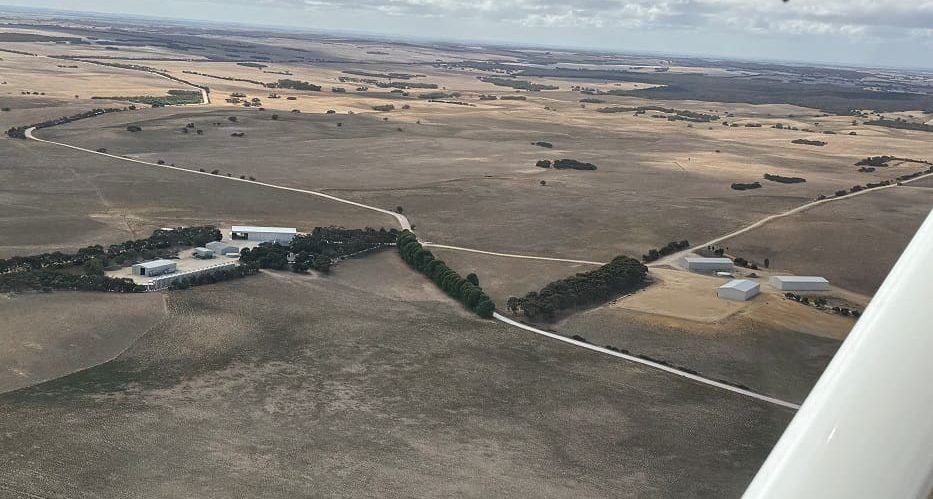
The drought is hitting parts of South Australia hard. Image – Tim Ford.
FEDERAL and state government assistance is needed urgently to meet the logistical challenge of meeting livestock fodder demands due to flood emergencies and drought across southern Australia, according to former Drought Taskforce member Tim Ford.
Mr Ford was a member of the Prime Minister’s Drought Task Force during the 2017 -2020 drought and is chief executive officer of the online fodder hub Feed Central.
Mr Ford said Australia is not in danger of running out of hay, with small quantities still available in the Northern Territory, Western Australia, New South Wales and Queensland, but there is almost none in South Australia and southern Victoria.
“The problem is the massive freight cost of transporting that product (from interstate).
“There are still options, there has been a little rain in the Riverina overnight, and that means there will be product in October, a bit of light at the end of the tunnel in new season product to take a little bit of pressure off the market,” he said.
“But basically the hay is absolutely exhausted in South Australia and southern Victoria, there is absolutely no doubt about that.”
He said the Australian livestock sector is facing a “really significant” logistics challenge to meet current hay demand, as southern producers faced winter without adequate pasture growth and flood-affected farmers needing to feed surviving livestock.
Mr Ford said the national hay stores were lower in the first week of 2020 before the drought started to break that year.
“That was complete exhaustion, this is not complete exhaustion.
“But there are very expensive and significant logistical challenges to move the (required) volume at a reasonable price.”
Mr Ford said the governments needed to work with the commercial sector and the charities to overcome the logistic and freight issues. He said the “epic” challenge facing livestock producers nationally is beyond the capabilities of the charities and the commercial sector on their own or together. This included managing issues like contracts, payment mechanisms, quality control and plant health protocols. The assistance focus needed to be on livestock producers, he said.
Many of thousands of tonnes of fodder were needed
Mr Ford said the fodder needs of the combined flood and drought emergencies was of the magnitude of many thousands of tonnes.
“You need 50,000 tonnes, 100,000 tonnes of hay moved over to get the demand in check.
“That creates a really significant logistics challenge even for the private sector and that pushes freight rates to extraordinary levels and puts huge pressure on the freight market,” he said.
Mr Ford said if the fodder logistics challenge is not addressed the exodus of livestock off southern Australian farms will continue.
“Coming into winter there is potential for a really significant animal welfare problem.
“A lot of people will be lambing and/or calving in late winter early spring, and even if it is warmer than normal it is still going to be harsh for a couple of months.
“Probably an almost war-like effort is required, with a combination of the commercial sector and government to bring product in from interstate, and it has to be controlled and that’s why the private sector has to be involved because we’ve got the systems and the processes to do it.”
Mr Ford said in the last drought the agricultural sector had a direct line into the Prime Minister’s office via the PM’s Drought Taskforce chaired by Major General Stephen Day.
“So we had a direct line to the Prime Minister’s office and we don’t have that this time.
“There is no connection.”
Mr Ford said former PM Malcolm Turnbull and Nationals MP Barnaby Joyce took a personal interest in the fodder supply situation.
“Stephen Day would give us a call five minutes before a taskforce meeting and say “I’ve got a meeting with the Prime Minister, what’s going on?’
“In those days, there weren’t a lot of options, there wasn’t the product in the country, whereas now the product is probably in the country, we’ve just got to get this logistics thing sorted out.”
Hay availability, cost and quality forces producers to grain
Glenburn farmer David Webb-Ware at a Farming In Unpredictable Conditions workshop at Molesworth told the ABC’s Victorian Country Hour that hay was becoming no longer an option because it was so expensive or unavailable and producers would be forced to transition to grain.
He said grain is really becoming the only option, although a lot of farmers in the area don’t have any facilities for handling grain, such as silos and augers.
“But it can be done by providing bunkers in the shed, using a front end load into a trailer feeder and trail feeding onto the ground is easy.
“People need to work out their cents per megajoule (of energy) and grain is probably half or less the cost of hay at the moment and I don’t think people have got an alternative, they’ve got to go to grain.”
Hay is moving from the north to the south
In his latest podcast, Mr Ford highlights the hay shortage across Australia as prices soar and hay heads from north to south in a rare reversal of supply flow.
“Flood recovery is still underway in parts of Western Queensland, while many regions in South Australia and Victoria are facing one of the driest autumns on record with empty sheds and key rainfall windows missed,” he said.
Mr Ford said while Queensland still has hay stock, this shift and the associated uncertainty means it’s selling faster than usual this season. Prices continue to climb, with cereal hay pushing $400 per tonne and lucerne up to $500 per tonne.
Mr Ford said Australia was used to weather extremes, but this season “seems more extreme than ever”.
Many communities are just recovering from prolonged flooding in western Queensland. About 2000 tonnes of hay was dropped from helicopters and trucked into the flooded regions, but Mr Ford said that had not made a significant impact on the fodder market.
However, the dry conditions in the south are heavily impacting on sellers, suppliers and farmers.
“There is tension in the marketplace and real anxiety about supply,” Mr Ford said.
“Southern regions like to have their autumn break by Anzac Day but that has passed and there has been no rain of significance through vast areas of South Australia and Victoria since then, which means there are zero pastures.”
Mr Ford recently toured clients’ farms in South Australia.
“It was as dry as I’ve ever seen it,” he said. “The dust was ready to go, the soils are very fragile and the groundcover is very low.”
Southern Queensland growers have experienced a run of good seasons, but Mr Ford warned against complacency.
“A level of complacency about hay supply has come into the market in Queensland but buyers need to be careful because the hay is going to slip south really quickly,” he said.
“In historical terms, we would never ship hay from Queensland south but the vast majority of South Australia and Victoria is totally exhausted of hay supply.
“You’ve got basically every shed empty. Hay in southern Queensland is going to be sold down fairly rapidly, fairly soon,” he said.
Most of Queensland remains unaffected by recent fire ant restrictions but most loads require the correct documentation for interstate movement, particularly into South Australia.

HAVE YOUR SAY